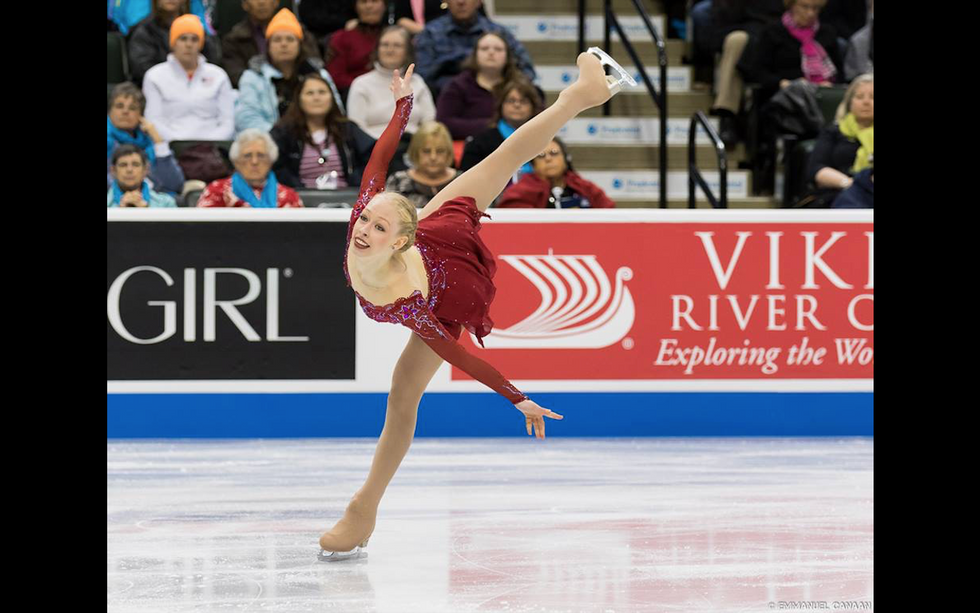As someone who used to figure skate—for ten years to be exact—the Winter Olympics are always a very exciting time. Not only do we get to cheer for our favorite soloists, dance pairs, or freestyle pairs, but we can see skaters from all over the world perform. Now don’t get me wrong; nationals, internationals, and local competitions for figure skaters are just as exciting. But there’s something so magical about the Olympics you can’t help but feel every year. However, as someone who spent a decade of her life on the ice, I’ve dealt with a lot of people in the past who seem to think figure skating still isn’t a sport, that it’s easy, or they just don’t get how difficult it is. So, if you consider yourself a fan of figure skating or are still skeptical, these are 5 things you need to know about figure skating.
1. Edges
When figure skating, it’s not just a matter of running through the motions. If you’re testing for freestyle or moves in the field—we’ll get to that later—you have to be aware of your edges. On a skate blade, there are two edges: the inside and the outside. They sound pretty self-explanatory, but hitting your edges in certain moves, jumps, or spins isn’t so simple.
If you don’t hit your edge just right, it could result in completely screwing up the move. Of course, you could also end up wiping out as well, depending on what you’re trying to do, so there’s that as well. When you watch figure skating live without the commentators constantly chit-chatting amongst themselves, you can clearly hear when a skater hits their edge just right: it’s that pleasant ripping sound. The sound every skater needs to hear to know they’re right on the mark.
2. Footwork
In competition, making sure the footwork is perfected is incredibly important. If you mess up the footwork sequence, it could put your entire program in jeopardy, no matter how well you might’ve skated the rest of the way. Once you hit a certain level in figure skating, when creating a program for competition, you have to have an entire footwork sequence that stretches from one end of the rink to the other. Now to someone who’s never figure skated before, that might sound very simple.
In reality, however, most figure skating rinks are at least a hundred feet in length: the Rockefeller ice skating rink is exactly 122 feet long. So a soloist or freestyle pair has to have an entire sequence of footwork to last them 122 feet lengths-worth without stopping. And the footwork has to be suitable for the level at which the skater is competing at. And don’t forget those edges!
3. Moves in the Field vs. Freestyle
In figure skating, there are two different aspects: moves in the field (or MIF) and freestyle. To put it simply, moves in the field involves learning the essentials of figure skating—crossovers, three turns, mohawks, etc.—as well as other forms of footwork that carry into competitions. Freestyle includes jumps and spins.
However, you also have to test for each of these. MIF tests are learned from a book created by the U.S. Figure Skating officials. This test is very straightforward: all you have to do is perform each move as designated in the book and the judges pass or fail you based on whether or not you did each move correctly. However, when it comes to freestyle tests, it’s a little harder. These kinds of tests involve creating a program to music and performing your footwork sequence, jumps, and spins.
Passing a freestyle test can get tricky because the judges analyze everything you do from your presence on the ice to the nitty-gritty of every jump, spin, and step you do during your footwork. Usually, you can tell whether or not you’ve failed your MIF test. In freestyle, you can feel really good about your performance and still end up having the judges disagree with you. Personally, passing a freestyle test was always way more satisfying.
4. Skating Dresses
Sometimes they’re really fun and comfortable to wear, other times they itch and it feels like you’ve been stuffed in a potato sack. Also, they’re very good for female figure skaters to wear because the lighter and tighter your clothing is, the easier it is to jump in the air for that triple axel. And having a sparkly dress is always a plus.
5. Jumps
The hardest thing about being a figure skater is learning the different types of jumps. And axels are the scariest. There’s a single, double, triple, and a quadruple axel. With any jump, you’re really just throwing yourself up into the air and praying to God you land correctly on one leg on your toe pick. You can’t under-rotate—pulling out of the jump too soon—or over-rotate—already spinning into the jump before you’ve taken off.
Jumping is very precise in figure skating. Of course, the professional skaters make it look so freaking easy because they’ve trained their entire lives for it! And even then, when the nerves get to you, sometimes you just can’t do it. It takes a lot to be able to do a jump with one, two, three, or even four and a half rotations.
Figure skating isn’t easy and it is a sport. A beautiful, graceful sport. Nothing in sports ever comes easily.
















